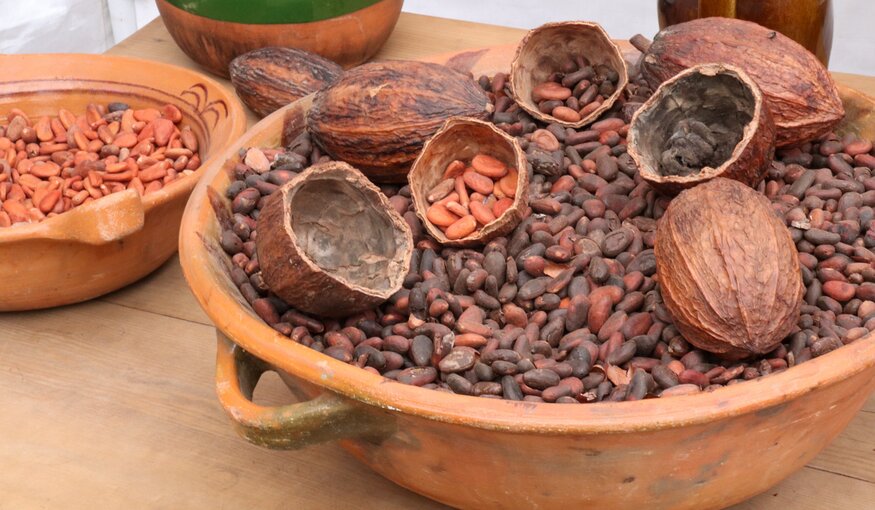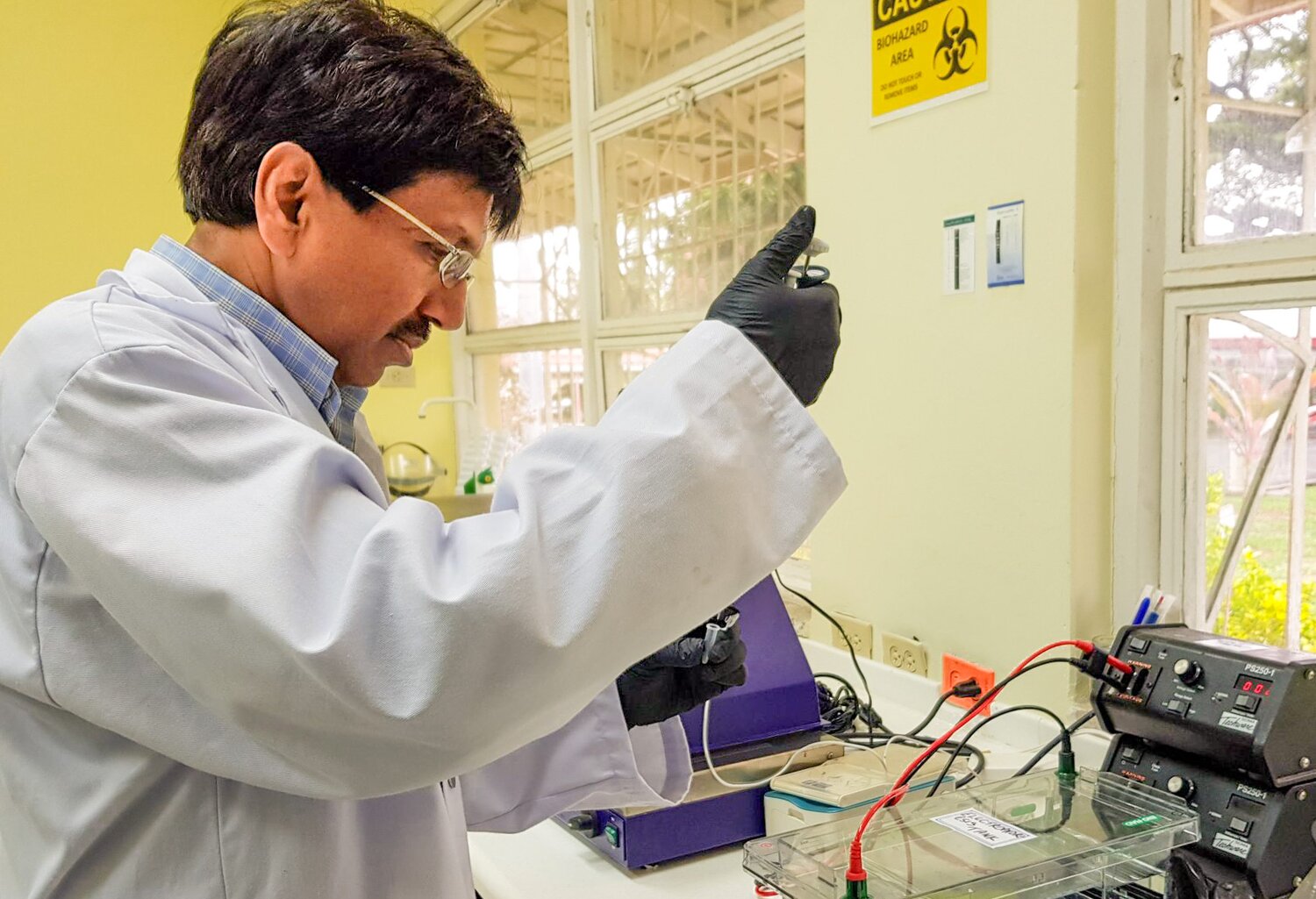A Conversation with Chocolate’s Noah

Cacao beans in traditional Mexican pottery. Photo: Rudolf Fanchini/Wikimedia Commons
7 July 2023
The origins of chocolate can be traced back to ancient Mesoamerican civilizations, who revered chocolate as the "Food of the Gods." They incorporated it into their sacred rituals and celebrated its medicinal properties.
Today, although reverence for it has evolved, chocolate continues to play a significant role in the global food system. Amidst our love for this delicious marvel, in all its myriad forms, we must consider the challenges that lie ahead. Climate change poses a risk to the chocolate bar’s crucial ingredient: the cacao bean. As with any other crop, changes in temperature and rainfall directly affect cacao yields.
Fortunately, there are genebanks around the world which safeguard cacao diversity. International collections are held at the Cocoa Research Centre (CRC) in Trinidad and at CATIE, the Tropical Agricultural Research and Higher Education Center, in Costa Rica. Currently, CATIE holds approximately 1,146 different types of cacao and CRC’s International Cocoa Genebank (ICG) about 2,400.
In honor of World Chocolate Day on July 7th, we sat down with Dr. Path Umaharan, Director of the Cocoa Research Centre at the University of the West Indies and curator of the ICG, an international genebank recognized under Article 15 genebank of the International Treaty for Plant Genetic Resources for Food and Agriculture.

Pathmanathan Umaharan (‘Uma’), Director of the Cocoa Research Centre, University of the West Indies, in his laboratory. Photo courtesy of The University of Nottingham
Crop Trust: Can you tell us a bit about yourself?
Dr. Umaharan: I have a BSc in Agriculture and a PhD in Plant Genetics. I am a Professor of Genetics at the University of the West Indies, the director of the Cocoa Research Centre at the university and the curator of the International Cocoa Genebank in Trinidad. My main interests are the genetic diversity of neotropical crop species and conservation genetics. Much of my work has been at the interface between genetics and plant pathology. I work on understanding the genes that determine a plant’s resistance to diseases and overcoming them through breeding or biotechnology. I have worked on fungal, bacterial and virus diseases in a number of crops species, including cowpea, pigeon pea, tomato, anthurium, hot peppers and cocoa, and have developed elite varieties of these crops.
How did you get into this field of work?
I have always been fascinated by genetic variation and how it has been used to overcome challenges in agriculture. My doctoral research work on cowpea’s resistance to Cowpea Severe Mosaic Virus fueled my interest in breeding for resistance to this virus and also to Cercospora Leaf Spot. This work energized me to look at other challenges in agriculture.
What excites you about what you do?
The genetic diversity that exists within the cacao genebank never ceases to amaze me. There has not been a single challenge for which we have not found a solution within the genetic resources in the genebank. I refer to it as the ‘wishing well’. Going from understanding genetic diversity, to creating innovative approaches to solve that problem has always been exciting – like building a puzzle and at the end seeing the whole picture in all its glory.
Tell us about the diversity you conserve at the International Cocoa Genebank.
The cacao genetic resources that we safeguard here have been meticulously collected from the centers of diversity of the crop in Peru, Ecuador, Colombia, Brazil, the Guianas and Central America, and conserved by the efforts of many scientists for almost a century beginning in the early 1930s.
At present the collection stands at 2,300 accessions, representing all of the 10 genetic groups identified to date and is regarded as the most diverse collection in the public domain. I’m pleased that it is able to support cacao breeding programs around the world. What’s also incredibly exciting and globally important is that the Cocoa Research Centre did a DNA fingerprinting study to support the identification of novel diversity globally.
What’s your favorite success story?
There are many. The genetic resources were assembled in Trinidad in the early 1900s to overcome a challenge the industry was facing following the devastation of the cacao industry by a fungal disease called witches’ broom. Following the identification of a resistance source within the genebank, a breeding program was initiated that has led to the development of varieties that are tolerant to the disease and has saved the country’s crop, and that of other countries in the region too.
More recently, with the advent of regulations in the European Union and other places that stipulated maximum allowable limits for cadmium, the industry in Latin America and Caribbean was under threat of not being able to comply. This happens naturally: cadmium can end up in chocolate because the plant takes it from the soil. Again, we had a look at what we had in our genebank and were able to identify genotypes that greatly limit uptake of cadmium into the beans.
What are the biggest threats to cacao genetic diversity today?
Certainly habitat loss. The Amazon River basin–the evolutionary nurturing ground for cacao genetic resources–is slowly being eroded away. The national collections in most countries are under-resourced and losing diversity. Given the short viability of the cacao seed, the crop has to be conserved as a living field collection of trees. This is not only costly to manage, but also exposes the collection to the vagaries and risks presented by the environment. The international collections are perhaps the last bastions of genetic diversity: the Noah’s Arks of chocolate. But they need funding, too. Secure funding. The arks of chocolate must not sink.

